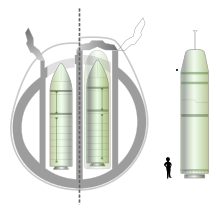M 51 (MSBS)
| M 51 (MSBS) | |
|---|---|
| General Information | |
| Type | Intercontinental ballistic missile ( SLBM ) |
| Local name | M51 |
| Country of origin |
|
| Manufacturer | EADS Astrium Space Transportation |
| development | 1996 |
| Commissioning | 2010 |
| Technical specifications | |
| length | 12.00 m |
| diameter | 2,300 mm |
| Combat weight | 56,000 kg |
| Drive First stage Second stage Third stage |
Solid rocket engine Solid rocket engine Solid rocket engine |
| Range | over 8,000 km |
| Furnishing | |
| steering | Inertial navigation platform plus astronomical navigation |
| Warhead | 6–10 MIRV nuclear warheads TN-75 with 100 kt each |
| Weapon platforms | Submarine |
| CEP |
150 - 200 m |
| Lists on the subject | |

M 51 (MSB) is the name of the French submarine-based intercontinental ballistic missile (MSB: French for Mer-Sol-balistique-Stratégique "meeresbodengestütze strategic ballistic weapon"), which the model since 2010 M 45 (MSB) progressive replacement. The missile range is a military secret . It is estimated at 8,000 km to 9,000 km. The M 51 is the result of a cost-optimized reverse development from the originally planned M 5 (MSBS) .
The rocket weighs 56 tons and is 12 meters high. Your APCP -Feststoffantrieb based on the solid boosters of Ariane 5 and also by EADS Astrium Space Transportation manufactured. As part of the Force de frappe , it can carry six to twelve ( MIRV ) TN-75 warheads, each with an explosive force of 100 kT . In the last French nuclear tests on Mururoa in 1995/1996 , the weapons tested achieved an explosive effect of 110 kT.
The M 51 is hardened against the effects of electromagnetic pulses EMP and more resistant to electronic countermeasures (ECM). It is controlled by means of an inertial navigation platform and astronavigation . With these two systems, an accuracy ( CEP ) of 150 to 200 m should be achievable. In order to make defensive measures by interceptor missiles more difficult, decoys are also released together with the warheads. The re-entry bodies should have stealth properties.
The development program for the M 51 cost EUR 8.5 billion. The unit price of a rocket is EUR 150 million. Up to 60 missiles are to be built. The Force océanique stratégique (FOST) has four nuclear submarines of the Triomphant class that can accommodate up to 16 missiles ( mer-sol balistique stratégique ).
The first ground-based test flight took place on November 9, 2006. The rocket took off shortly before Bordeaux and crossed the Atlantic in about 15 minutes. After three test flights fired from the ground , the first sea-based launch took place in the Bay of Audierne on January 27, 2010 from the youngest and last boat of the Tromphant class submarine, the Le Terrible . A test flight failed on May 5, 2013. The missile launched from the submarine Le Vigilant (S618) off the coast of Brittany, which carried no warheads, destroyed itself in the first phase of flight over the Atlantic.
The M51 has been operational since the end of 2010. At the end of 2018, the submarines Le Triomphant and Le Vigilant were equipped with M51 missiles.
Web links
- Airbus Defense and Space - M-51
- Report at Heise about the first start
- Action alliance of French peace groups against the M 51
Bibliography
- Chris Chant: Modern submarines technology-tactics-armament , Motorbuchverlag, Stuttgart, 1st edition 2005, ISBN 3-7276-7150-5
- ↑ France test-fires submarine-launched missile
- ↑ spiegel.de: Failed test: French nuclear missile destroyed , from May 5, 2013
- ↑ Dieter Stockfisch: New SLBM M51. In: esut.de. European Security & Technology, November 1, 2018, accessed December 20, 2018 .
